
In Tainted Grail, not all Encounters end in Combat. There is also a separate, blue Encounter deck for diplomatic challenges and so- cial confrontations your Character might need to navigate. They play similarly to Combat, so if you're already familiar with it, learning Diplomacy should be easy.
Basic Diplomacy Overview
Diplomacy in Tainted Grail is a turn-based confrontation between a Character (or a Party of Characters) and an oppo- nent, represented by the Encounter card.
Together, Characters build a long line (Sequence) of cards, with the aim of pushing a marker on the Encounter card's Affinity track to the top. In the meantime, the opponent will push the marker in the opposite direction while performing various Responses.
The detailed rules of Diplomacy are described further down, but in general, most Diplomatic Encounters play out like this:
All Party members draw their initial hands of cards (see Starting Diplomacy).
The Party members pick a Character who becomes Active and goes first (Diplomacy Turn, step I).
The Active Character may play one Diplomacy card, adding it to the end of the Sequence (Diplomacy Turn, step II).
The Active Character may play as many additional Diplo- macy cards as the rules allow (Diplomacy Turn, step II).
The opponent Responds to the Active Character (Diplomacy Turn, step III).
If there are Characters who were not Active this Turn, one of them becomes Active. If not, the Turn ends and a new Turn begins.
Some Diplomatic Encounters allow for two alternative approaches or have several numbered Stages, each of them requiring you to "win" the Affinity track mini-game a second (or even third) time in a row, under different conditions.
Hint: Apart from Escaping them, some Diplomatic Encounters give you an option to avoid them altogether, provided you have enough Rep or Resources (see: Escaping or Avoiding Diplomacy).

Diplomacy Sequence Example
A Sequence consists of Diplomacy cards played during a Diplomatic Encounter by all Party members. Every Character plays their cards, adding them to one, shared Sequence. Cards always form a straight line. The columns of Keys always line together, so that no Key is obscured.
Escaping or Avoiding Diplomacy
A Party may always Escape a Diplomatic Encounter - simply apply the penalty listed in the "Failure" section of the card to each Party member.
If the card has an "Avoid" section at the bottom, you may decide to bypass the Encounter. In that case, you need to pay all costs and meet all requirements stated in the "Avoid" section. Then, put this Encounter card at the bottom of the Blue Encounter deck and continue the game.
You can only Avoid an Encounter before you start it! Once Diplomacy begins, you are no longer allowed to Avoid.
In a Party: When Avoiding, always check the highest Rep or Attribute levels (do not sum them up). The cost of Avoiding or
Failure applies to each Party member separately. If Party members can't reach a unanimous decision about Avoiding or Failing the Encounter, they must resolve it.
Encounter Card
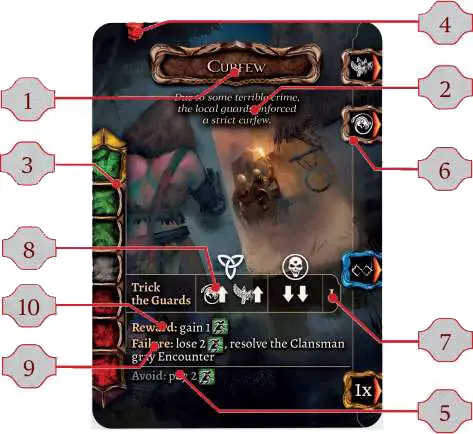
This card represents a typical Diplomatic Encounter. It consists of several parts:
- Card Name.
- Flavor text.
- Affinity Track. Many effects can push a marker on this track up or down. Some Abilities also check whether the marker is currently on green or on red.
- Encounter Difficulty. Each Diplomatic Encounter belongs to one of the four difficulty categories, from the easiest to the hardest.
- Avoid. The cost and requirements of Avoiding the Encounter (see: Escaping or Avoiding Diplomacy).
- Attribute Keys. Connecting these Keys grants various bonuses, if you have the required level in a given Attribute.
- Stages. Each stage requires you to "win" the Affinity track tug- of-war, following different rules.
- Diplomacy Table. Use it to determine which Response the opponent performs during the Response step.
- Failure. The cost of losing the Encounter. Applies to each Party member.
- Reward. The reward for winning the Encounter. Each party member gains the reward listed here (you don't need to share it).
Starting Diplomacy
Diplomacy in Tainted Grail starts whenever the game asks you to draw or pick a card from the blue Encounter deck, and the card you draw has at least one open Key on its right edge.
After drawing an Encounter card, set it on the board, ensuring you have plenty of space to the right - you will build your Sequence there.
Then, all Party members make sure whether they're not using more than one Item with each of the following keywords: Weapon, Shield, Armor, Companion, Relic (see: Items and Secrets).
Party members may also decide not to use some of their Items in this Encounter. Set these unused Items aside for the duration of this Encounter. No Items may be added once you enter Diplomacy!
After confirming their equipment, each Party Member draws a number of cards from their Diplomacy Deck:
- 3 cards if there are 1-3 Characters in the Encounter.
- 2 cards if there are 4 Characters in the Encounter.
If you don't like your starting hand, you can discard it and draw a new hand with one less card. You may repeat this this until you only have one card left in your hand.
When all the Party members have their starting cards, Diplomacy begins - place a marker in the gray slot of the Affinity track and go to phase I of the Diplomacy Turn, described on the next page.
Diplomacy Card

This is an example of a Diplomacy card which you will use to defeat your opponent during a Diplomatic Encounter.
-
Attribute Keys. Each of them is open and may connect to one Bonus Key on the next card in the Sequence. Icons in the Attribute Keys correspond to Attributes on the Character Tray. If you do not have the required level in a given Attribute, the Attribute Key won't connect!
-
Bonus Keys. Each of these Keys may connect to one Attribute Key on the previous card in the Sequence.
-
Magic Key. This Key connects if you join its left part with its right part AND spend 1 point of Magic.
-
Free Key. This Key always connects for free and grants you a bonus, specified in the second part of the Key. Each Bonus is explained in detail in the "Diplomacy Bonuses" frame. If the second part of this Key is empty, you don't receive anything.
-
Ability. The text part of the card containing special rules, with various timings. Only Abilities that are visible (and not covered by other cards in the Sequence) are considered active. Passive cards (see below) are never covered, so their Abilities remain in play throughout the En- counter.
-
Card Number. To make sorting through cards and building decks easier, each Combat and Diplomacy card has a unique number. The letter next to the number identifies the card's deck and color (U - blue, G - green, B - brown, Y - gray).
Passive Diplomacy Cards
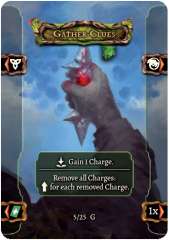
Unlike regular Diplomacy Cards, passive Diplomacy cards always have their Ability visible when in Sequence. To facilitate that, their Keys are on the opposite edges of the card.
Charges: Some cards instruct you to gain Charges - use universal markers and place them on the card. You can use "Pay x Charges" Abilities any time you want.
In a Party: Only the Active Character can use Charges from cards, but the owner of the card must agree.
Diplomacy Turn
A Diplomatic Encounter usually consists of several Turns, with each Turn going through the following phases:
I. Pick the Active Character
The Party members decide who will be the next Active Character. They can select from any Character who has not been Activated this Turn (they have no Time Token on their Character Tray).
If players can't reach a unanimous decision, the Character with the lowest Character Number who was not Activated yet this Turn becomes Active.
Place a Time Token on the Tray of the Character who became Active. It will remind you this Character cannot be Activated again until the next Turn.
Keep in mind that any gameplay effects ( ,
,  gain, Ability penalties) that happen during the Character Activation apply only to the Active Character!
gain, Ability penalties) that happen during the Character Activation apply only to the Active Character!
II. Character Activation
1. Delayed Abilities
Remove one Time Token from each Diplomacy card in the Sequence that has any. If you've removed the last Time Token from a card, immediately resolve its Ability with the Time Token trigger (see: "Diplomacy Card Triggers" frame). These abilities trigger only once!
Go to step 2.
2. Playing Cards
This is where you execute your plan, playing cards from your hand and adding them to the Sequence. You may also be forced to play a card if you're affected by Panic (see: Panic).
To complete this step, follow the list below:
-
Play one Diplomacy card. When playing the very first card during your Activation, you don't need to fulfill any special requirements! This card doesn't have to connect to any Bonuses or Keys.
It just needs to line properly with the previous card in the Sequence, which will cause its bottom Key to join with the bottom Key of the previous card. After you play the card:
Check if any Attribute Keys connect to Bonus Keys. Apply these Bonuses. Remember that in order for them to connect, you need to have the Attribute level specified by the Key.
If both parts of a Magic Key join, you may connect this Key by paying 1 Magic and gain its Bonus.
Connect the bottom, Free Key and gain its Bonus.
Check the Ability. If it triggers now (see Ability Triggers), resolve it.
-
Play additional Diplomacy cards. Each Turn, every Diplomacy card you play after your first one MUST connect with a
 Key. If you have no cards that have this Bonus Key, or you can find no way to connect it, you may not play any additional cards! Resolve any cards you play just like above.
Key. If you have no cards that have this Bonus Key, or you can find no way to connect it, you may not play any additional cards! Resolve any cards you play just like above.Please note: the
 icon must appear on the card you want to play (not the one before), to become connected.
icon must appear on the card you want to play (not the one before), to become connected.
-
Perform the Affinity Check. See the Affinity Check frame for details. Then, go to step 3.
Affinity Check
Check the position of the marker on the Affinity track.
If it's on the lowest slot, you lose the Encounter - apply the Failure rules to each Party member, and put the Encounter on the bottom of its deck. Then, reshuffle your Diplomacy deck.
If it's on the highest slot, you win the current Stage of the Encounter. If this was the last Stage, you win the entire Encounter - receive Rewards, place the Encounter card on the bottom of its deck, then reshuffle your Diplomacy deck.
If this wasn't the last Stage, begin the next Stage - move the marker to the gray slot on the Affinity track, place a marker on the completed Stage, and go to the Check Readiness step.
3. Opponent's Response
On the Encounter card, find the Response for the current Stage of this Encounter. Apply this response to the Active Character. Then, perform the Affinity Check (see: "Affinity Check" frame).
Go to step 4.
4. Check Readiness
Check if all of the Party Members have been Activated during this Turn (and have a Time Token on their Character Trays). If there are no Characters left to Activate, go to the End Turn phase (III).
If there are still Characters who haven't been Activated, go back to "Pick the Active Character" phase (I).
III. End Turn
Discard. Each party member discards down to 3 cards in their hand.
Draw. All Party members draw 1 card from their decks. Do not draw, if your Character Panics.
Start new Turn. Go back to the start of phase I (Pick the Active Character)!
Connected Keys
For any Key to be connected, both halves of the Key need to join. Additionally:
 Your Character must have the appropriate Attribute level.
Your Character must have the appropriate Attribute level.
 You must spend 1 point of Magic if you want to connect it. Place this point on the Magic Key to indicate it is active. If you have to discard a card with a Connected Magic Key, you discard the Magic point used to Connect this Key.
You must spend 1 point of Magic if you want to connect it. Place this point on the Magic Key to indicate it is active. If you have to discard a card with a Connected Magic Key, you discard the Magic point used to Connect this Key.
 Always connects! Free Keys often connect with multipliers, making them even more potent!
Always connects! Free Keys often connect with multipliers, making them even more potent!
Diplomacy Card Trigger Icons
Most Diplomacy cards have an ability. Abilities usually start with a Trigger icon that clearly indicates when you should resolve them.

On Placement - resolve this Ability immediately after placing the card in the Sequence.

Delayed - put a Time Token on this card as you play it. The Ability is triggered after removing the very last Time Token from the card. The Ability does not trigger on subsequent Turn, and the Time Token does not return!
If you put another card on a card with a Time Token, and you cover the Ability, the Time Token is lost and the Ability won't trigger.

On Opponent's Response - this Ability remains active throughout the entire step 3, usually modifying the opponent's Response.

Damage - this icon means your Character has to lower their  by the indicated amount.
by the indicated amount.

Connected Attribute Key - this icon means the number of connected Attribute Keys of this specific type in the entire Sequence.
Diplomacy Bonuses

Move the marker up or down the Affinity track.

This Bonus is determined by the Encounter card and the Attribute it attaches to. Go to the description of the current Stage on the Encounter card and see if it contains a rule corresponding to the Attribute this Bonus is connected with.

Draw a card.

his Bonus Key allows you to play additional Diplomacy cards during step 2 of your Activation (see: Playing Cards). Ignore this Key when playing your first Diplomacy card in the Activation.
This Bonus does not multiply - if it's next to the multiplier, ignore the multiplier.

Discard the last card of your Sequence.

Multiplies the next icon.

Voids the next icon.
Other Diplomacy Rules
Panic
Panic takes place anytime your  is higher than your current
is higher than your current  (terror marker is higher than the wings of the T-shaped limiter). When that happens:
(terror marker is higher than the wings of the T-shaped limiter). When that happens:
Instead of playing the first card of this Turn from your hand in step 2 (Playing Cards), play a card from the top of your Diplomacy deck. Then, you may play any additional cards from your hand, according to the standard rules.
Do not draw a new card at the End of Turn. Any bonus or extra cards gained from Bonus Keys, Skills or Abilities are still drawn as normal.
No Cards in Deck
Whenever your Character has to draw any Diplomacy cards and their Diplomacy deck does not have the required number of cards, you Fail the Encounter. Apply the Fail rules from the Encounter card.
You are Dying!
Whenever your  drops to 0, your Character gets a "You Are Dying" card. Among other rules, the card immediately ends the current Encounter - see its text for more details.
drops to 0, your Character gets a "You Are Dying" card. Among other rules, the card immediately ends the current Encounter - see its text for more details.
Discarding From An Empty Hand
Whenever you have to discard a card from your hand, but you don't have any cards, discard a card from the top of your Diplo- macy deck instead.
Diplomacy Example
Arev draws a Weeping Orphan blue Encounter. This Encounter has two Stages. The player has to complete Stage 1, and then Stage 2 in order to win. The player places a marker on the gray slot of the Affinity track.
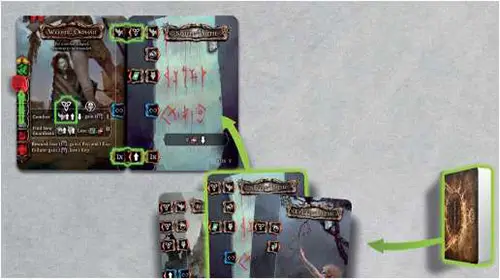
First Stage - Turn 1
It's the first round of the Encounter, so the player draws 3 cards
from their Diplomacy deck. Then, the player plays a Simple Truth card. Arev has 1 point of  , so he gains the bonus from the connected
, so he gains the bonus from the connected  Key - it's a
Key - it's a  symbol.
symbol.
The player checks the meaning of the symbol on the Encounter card - for Stage I, any  moves the Affinity marker two slots up on the track. The Free Key of the Simple Truth card also connects - it contains a
moves the Affinity marker two slots up on the track. The Free Key of the Simple Truth card also connects - it contains a  symbol, so the player moves the marker another slot up.
symbol, so the player moves the marker another slot up.
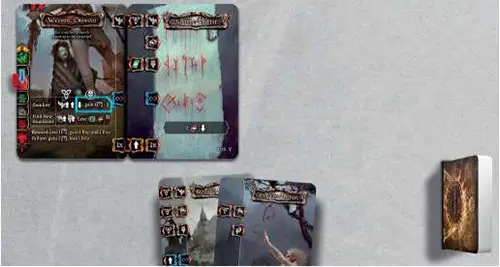
The player doesn't have any cards with  symbol, so they can't play anything more and end their Turn.
symbol, so they can't play anything more and end their Turn.
The marker is not on the last slot on the track, so it's time for the opponent's Response - it moves the marker 1 slot down. Arev also gains 1 point of  .
.
The player draws 1 card.
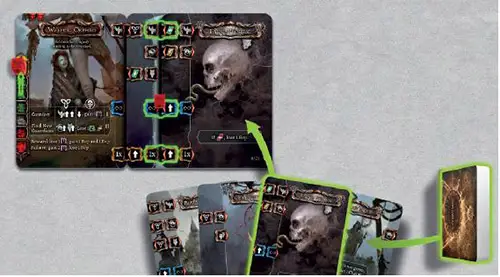
First Stage - Turn 2
The player plays a False Promise - they want to gain the bonus from the Magic Key, so they spend 1 point of Magic. The player additionally gains bonuses from connected  and Free Keys.
and Free Keys.
The player draws a card and moves the marker two slots up the Affinity track. It's the last slot on the track, so the player decides to end their Turn.
During the "Affinity Check", the player advances to the next Stage of the Encounter and moves the marker on the Affinity track back to the gray slot. The Turn has ended, so there is no Response.
The player draws 1 card.
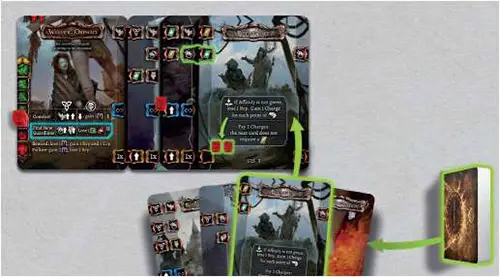
Second Stage - Turn 3
The player plays a Bleak Joke. It's the first played card, so the player ignores the  symbol. Then, the player draws 1 card because of the connected
symbol. Then, the player draws 1 card because of the connected  Key. Finally, the player checks the
Key. Finally, the player checks the  .
.
The Affinity is not green, so the player loses 1 Rep. Then, the player places 1 Charge on the card.
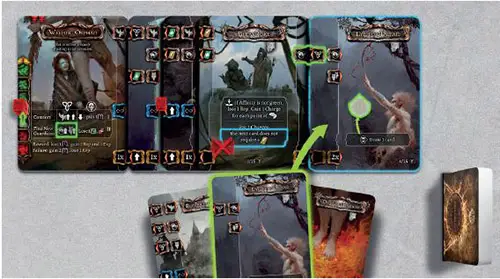
Now, the player spends 1 Charge from the Bleak Joke card to play an Eye for Detail card as if it was connected with  . The
. The  Key connects, and it has the
Key connects, and it has the  symbol. The player consults the table on the Encounter card, then moves the marker 1 slot up on the Affinity Track.
symbol. The player consults the table on the Encounter card, then moves the marker 1 slot up on the Affinity Track.
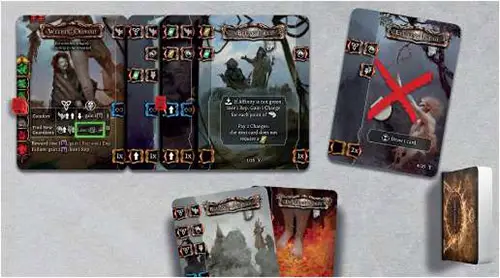
It's time for the opponent's Response. Arev loses 1  and destroys the last card in the Sequence. The Eye for Detail card is discarded along with its Time Token. Now, the last card in the Sequence is the Bleak Joke card.
and destroys the last card in the Sequence. The Eye for Detail card is discarded along with its Time Token. Now, the last card in the Sequence is the Bleak Joke card.
The Encounter continues until Arev manages to push the marker to the top of the Affinity track and completes the Second stage.
Continue Reading